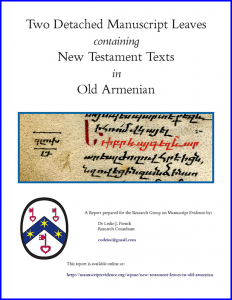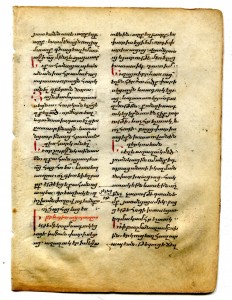The Plot Thickens
June 7, 2019 in Manuscript Studies, Reports
A New Leaf Found at the University of Pennsylvania
from the
“Kurdian/Chicago New Testament Praxapostolos[?]
in Old Armenian”
The “Find-Place” of this Fragment
is a Surprise
also for Our Research on “Otto Ege Manuscripts”
[In our series of blogposts on Manuscript Studies, Mildred Budny (see Her Page) reports the unexpected discovery of another leaf from the same dismembered manuscript with portions of the New Testament in Old Armenian featured in an earlier blogpost, published on 28 September 2015, with an illustrated Report available for download. Now we prepare for an updated, downloadable Report by describing the New Find and its location.]

Cover for “Two Detached Manuscript Leaves containing New Testament Texts in Old Armenian” (2015).
First the Report So Far. As part of the process of exhibiting images from manuscripts, documents, and other written materials — for example in our Galleries of Scripts on Parade and Texts on Parade, and in our Reports on Manuscript Studies — we offered a Report on ‘Two Detached Manuscript Leaves containing New Testament Texts in Old Armenian’ by our Associate, Leslie J. French. The Report focuses upon the evidence of some New Leaves (as they came into our view), considering their materials, layout, text, apparatus, and language, with reference to the knowable features of other remnants of the manuscript, particularly the Chicago Leaf, and some relatives among other representatives of New Testament texts in Old Armenian written in bolorgir script and accompanied in the margins by the Euthalian apparatus.
The Report booklet is available for download in 2 versions. They respect options for printing which might be available to you.
- ArmenianPages set out in individual letter-sized (or quarto) pages
- ArmenianBooklet laid out on 11″ × 17″ sheets for folding into a 20-page booklet in consecutive reading order
Specifically for that Report, Armenian characters in both lower case and upper case were added to the multi-lingual digital font Bembino of the Research Group on Manuscript Evidence. For information about the font and its current version, free for download and use, see Bembino. A booklet demonstrates specimens in multiple languages, Armenian included, of the appearance on the page of Multi-Lingual Bembino.
Booklet ‘On Demand’

Folio Ir of Armenian New Testament fragment. Acts of the Apostles
This Report is available below for download as PDF. In the form of a booklet, it presents its materials laid out in the official font of the Research Group on Manuscript Evidence, Bembino, a multilingual digital font (which you see on this website), and in accordance with the principles of our Style Manifesto. Such an approach resembles the presentation of our Newsletter ShelfMarks in booklet form, likewise available freely for download — as are the Style Manifesto and the descriptive booklet, with specimens, for Bembino. The font itself is also FREE for download here (now in Version 1.3).
The Report examines and illustrates two detached leaves in Old Armenian which came to our attention when preparing their presentation among other specimens in various languages in our Gallery of Scripts on Parade. Then, identifying the passages of text and the elements of textual apparatus on the leaves proceeded hand in hand with an exploration of the available evidence, or records, for other parts of the same manuscript dispersed in several collections. Designing Armenian characters, lowercase and uppercase, for Bembino (in its next version, still in progress, responding to requests) allowed for the collation of the texts in full, as an aid to decipherment for readers who may be unfamiliar with the language or the medieval script forms. And so the booklet took shape.
The Manuscript in Question
These leaves, now in several collections, both private and institutional, preserve parts of dismembered manuscript in Old Armenian written in bolorgir minuscule script of the 15th or 16th century CE. The remnants contain parts of the New Testament (some observers say a Lectionary), plus a Prayer (or its opening line) and a Scribal Colophon (of unknown contents), now dispersed in parts among several collections worldwide.
